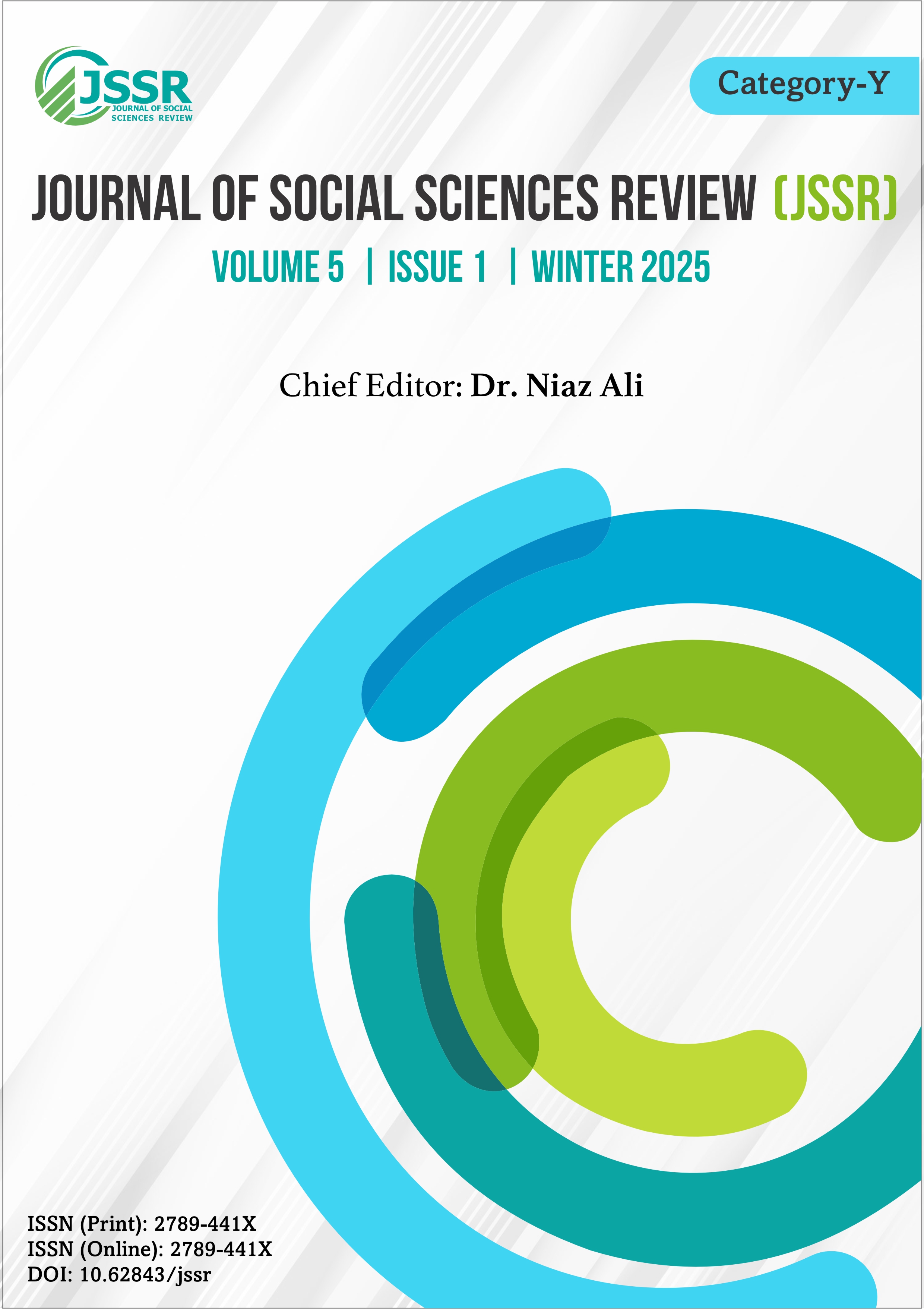Association between In-Laws Relationship and Domestic Violence Against Women
DOI:
https://doi.org/10.62843/jssr.v5i1.464Keywords:
Domestic Violence, Women, In-Laws Relationship, District Upper Dir, Economic Empowerment ProgramsAbstract
This study aims to investigate the impacts of in-laws' relationship with domestic violence against women followed by the quantitative analysis approach, based on a positivist paradigm usually based on a large sample size with statistical interpretation. The study was conducted in three villages of Union Council Darora such as Bar Cham, Koz Kas and Qala (Gandigar), District Upper Dir, Khyber Pakhtunkhwa Pakistan. The data were collected from 248 women above 25 years of age through questionnaires. The data were analyzed by descriptive and inferential statistics. The research found that domestic violence is often associated with in-law relationships. The resistance of women to their family obligations, lesser amount of dowry, restriction on women's movement and excessive social interaction are associated with domestic violence. Similarly, controlling women's autonomy by their mother-in-law, maintaining family honor, social stigma and more demands of women were the common reasons associated with domestic violence against women. Economic empowerment programs should aim to enhance women’s economic security, independence, and decision-making power. Social Support services, including counselling, legal aid, and shelter, should be strengthened and expanded to reach more survivors of domestic violence.
References
Agrawal, S., Zadimoghaddam, M., & Mirrokni, V. (2018, July). Proportional allocation: Simple, distributed, and diverse matching with high entropy. In International Conference on Machine Learning (pp. 99-108). PMLR.
Ali, T. S., Árnadóttir, G., & Kulane, A. (2013). Dowry practices and their negative consequences from a female perspective in Karachi, Pakistan—a qualitative study. Health, 5(7D), 84. https://ecommons.aku.edu/pakistan_fhs_son/160
Amnesty International. (2009). Violence is not just a family affair: Women face abuse in Tajikistan. Amnesty International.
Bentley, J. W., Christensen, T. E., Gee, K. H., & Whipple, B. C. (2018). Disentangling managers’ and analysts’ non‐GAAP reporting: Disentangling non-gaap reporting. Journal of Accounting Research, 56(4), 1039–1081. https://doi.org/10.1111/1475-679x.12206
Bhuiya, A., Sharmin, T., & Hanifi, S. M. A. (2003). Nature of domestic violence against women in a rural area of Bangladesh: implication for preventive interventions. Journal of Health, Population and Nutrition, 48-54. https://pubmed.ncbi.nlm.nih.gov/12751674/
Chaudhry, A., & Amis, J. (2022). Negotiating masculinities in times of crisis: On the COVID frontline in Pakistan. Gender, Work, and Organization, 29(2), 650–665. https://doi.org/10.1111/gwao.12800
Jewkes, R. (2002). Intimate partner violence: Causes and prevention. The Lancet, 359(9315), 1423-1429. https://doi.org/10.1016/S0140-6736(02)08357-5
Kim, J. C., Watts, C. H., Hargreaves, J. R., Ndhlovu, L. X., Phetla, G., Morison, L. A., Busza, J., Porter, J. D. H., & Pronyk, P. (2007). Understanding the impact of a microfinance-based intervention on women’s empowerment and the reduction of intimate partner violence in South Africa. American Journal of Public Health, 97(10), 1794–1802. https://doi.org/10.2105/AJPH.2006.095521
Rahman, F., Rahman, K.U. & Masroor, M. (2025). Unveiling the Effects of Workplace Harassment on Women Workers in the Higher Education Institutions, Khyber Pakhtunkhwa. Journal of Social Sciences Research & Policy (JSSRP), 3(1), 165–171.
Raj, A., & Silverman, J. G. (2007). Intimate partner violence against South-Asian women in greater Boston. Journal of the American Medical Women's Association, 62(2), 1-9.
Rew, M., Gangoli, G., & Gill, A. K. (2013). Violence between female in-laws in India. Journal of International Women's Studies, 14(1), 147-160. https://vc.bridgew.edu/jiws/vol14/iss1/9
Rew, W. J. (2013). Instructional leadership practices and teacher efficacy beliefs: Cross-national evidence from TALIS (Doctoral dissertation, The Florida State University).
Robinson, R. A., & Ryder, J. A. (2013). Psychosocial perspectives of girls and violence: Implications for policy and praxis. Critical criminology, 21, 431-445. http://dx.doi.org/10.1007/s10612-013-9185-4
Sekaran, U. (2003). Research Methods for Business. USA: Hermitage Publishing Services.
Simons, R. L., & Johnson, C. (1998). An examination of competing explanations for the intergenerational transmission of domestic violence. In International Handbook of Multigenerational Legacies of Trauma (pp. 553-570). Springer, Boston, MA.
Suneetha, A. S. R. V., & Nagaraj, V. (2006). A difficult match: Women's actions and legal institutions in the face of domestic violence. Economic and Political Weekly, 4355-4362. http://www.jstor.org/stable/4418811
Turaeva, M. R., & Becker, C. M. (2022). Daughters-in-law and domestic violence: Patrilocal marriage in Tajikistan. Feminist Economics, 28(4), 60–88. https://doi.org/10.1080/13545701.2022.2060518
Ullah, S., Jan, S. U. K., Alam, A., & Tasleem, M. (2025). The impacts of international labour migration on indigenous productivities in Khyber Pakhtunkhwa, Pakistan. The Journal of Research Review, 2(01), 44-51. https://thejrr.com/index.php/39/article/view/81
Vandello, J. A., & Cohen, D. (2003). Male honor and female fidelity: implicit cultural scripts that perpetuate domestic violence. Journal of Personality and Social Psychology, 84(5), 997-1010.
Downloads
Published
Issue
Section
License
Copyright (c) 2025 Copyright in the Journal of Social Sciences Review is retained by the author(s). Authors also grant any third party the right to use the article freely as long as its integrity is maintained and its original authors, citation details and publisher are identified.

This work is licensed under a Creative Commons Attribution-NonCommercial 4.0 International License.
SSR's Editorial Board shares the vision of providing free access to information, education, and science for everyone, thus promoting its content through an OPEN ACCESS POLICY, fulfilling the DOAJ definition of open access. The JSSR adheres to an Open Access and Copyright Licensing Policy based on the belief that making research freely accessible to the public promotes greater global knowledge sharing.
The JSSR uses the Creative Commons Attribution-NonCommercial 4.0 International License. The authors who apply and publish in JSSR consent to abide by the copyright policy set out in the Creative Commons 4.0 license (Attribution-NonCommercial 4.0 International license).
- Copyright in the Journal of Social Sciences Review is retained by the author(s).
- Authors also grant any third party the right to use the article freely as long as its integrity is maintained and its original authors, citation details and publisher are identified.
While "By 'open access' to this literature, we mean its free availability on the public internet, permitting any users to read, download, copy, distribute, print, search, or link to the full texts of these articles, crawl them for indexing, pass them as data to software, or use them for any other lawful purpose, without financial, legal, or technical barriers other than those inseparable from gaining access to the internet itself."



